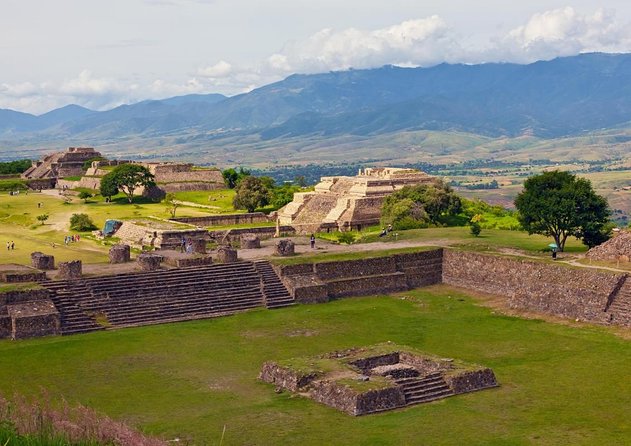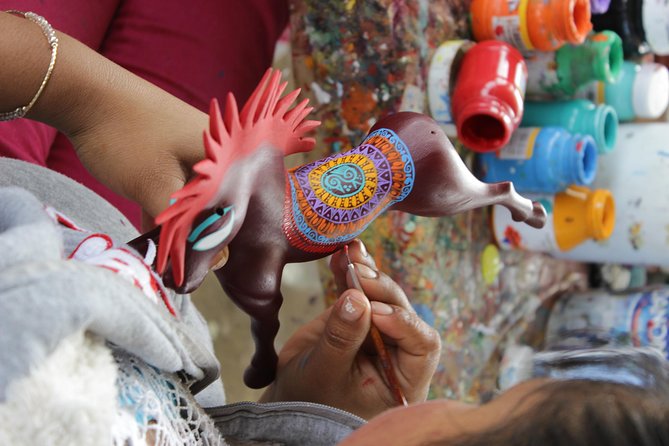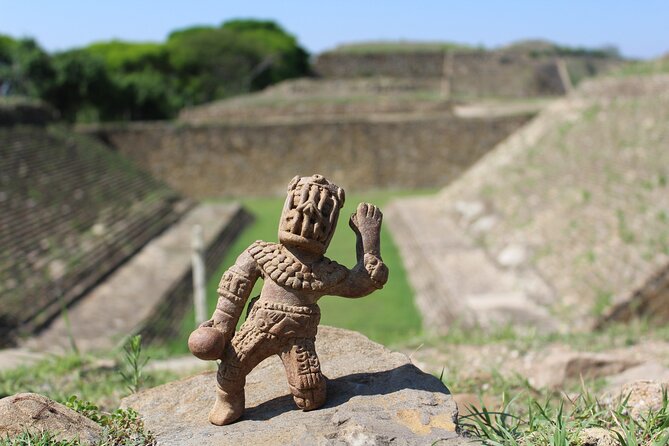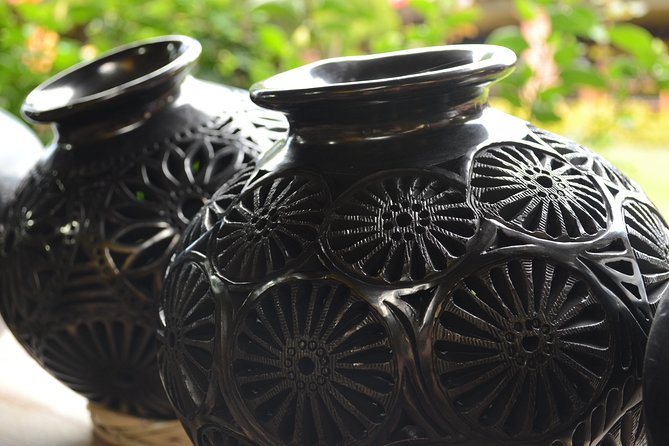Nestled in the heart of the picturesque Oaxaca Valley, Monte Albán, Arrazola, Cuilapam, and San Bartolo Coyotepec are like the vibrant brushstrokes on a canvas, each adding its own unique color and texture to the tapestry of Mexican history and culture.
As the sun rises over the ancient ruins of Monte Albán, casting an ethereal glow upon the stone carvings and sacred platforms, visitors can’t help but feel a sense of awe and wonder.
This is just the beginning of a captivating journey that will take them through the charming town of Arrazola, where whimsical woodcarvings come to life, to the colonial splendor of Cuilapam, and finally to the world of pre-Columbian black pottery in San Bartolo Coyotepec.
Intrigued? Prepare to be transported to a world of captivating stories and hidden treasures as we uncover the secrets of these remarkable destinations.
Good To Know

- Oaxaca Valley offers a full-day trip with a guided coach tour to various destinations.
- Monte Alban is a UNESCO-listed archaeological site with stunning panoramic views and a rich Zapotec history.
- San Antonio Arrazola is known for its famous woodcarvings called alebrijes and offers a chance to explore local folk art.
- Cuilapam de Guerrero is home to the 16th-century Cuilapam Convent and offers the opportunity to learn about indigenous conversion and colonial history. San Bartolo Coyotepec is known for its black pottery tradition and features a 16th-century church and a craft market displaying local ceramics.
Oaxaca Valley Full-Day Trip

The Oaxaca Valley Full-Day Trip offers an immersive experience, taking visitors on a guided coach tour to explore the rich cultural and historical treasures of Monte Albán, Arrazola, Cuilapam, and San Bartolo Coyotepec.
Along the journey, visitors will have the opportunity to indulge in the unique flavors of Oaxaca Valley cuisine and witness the intricate craftsmanship of traditional crafts and textiles.
Oaxaca Valley cuisine is renowned for its bold flavors and vibrant ingredients, showcasing the region’s culinary heritage. From savory mole sauces to fragrant tlayudas, visitors will have the chance to taste the authentic flavors of Oaxaca.
In addition, the trip will also showcase the incredible traditional crafts and textiles produced by the skilled artisans of the region. From intricately woven textiles to beautifully carved wooden alebrijes, visitors will witness the artistry and dedication that goes into creating these timeless treasures.
The Oaxaca Valley Full-Day Trip is a captivating journey that highlights the rich cultural and artistic traditions of the region.
Find more activities and experiences we've covered in Oaxaca City.
Highlights of Monte Alban

Perched atop a mountaintop with panoramic views, Monte Alban offers a captivating journey through Zapotec history and culture. This UNESCO heritage site allows visitors to explore the rich heritage of the Zapotec people.
Here are the highlights of Monte Alban:
Explore the archaeological site: Spend about 2.5 hours navigating through the ancient ruins, guided by knowledgeable experts who provide insights into Zapotec history and culture.
Witness The Dancers: Marvel at the ceremonial platforms and rock carvings known as The Dancers, which hold great significance in Zapotec culture.
Discover the architectural wonders: Visit the pyramids, temples, altars, and the I-shaped ball court, which showcase the impressive architectural prowess of the Zapotec civilization.
With its breathtaking location and profound historical significance, Monte Alban is a must-visit destination for anyone seeking to enjoy the wonders of Zapotec culture.
San Antonio Arrazola

Nestled at the base of Monte Alban, the tranquil town of San Antonio Arrazola captivates visitors with its renowned woodcarvings and enchanting folk art.
This charming village is known for its mystical woodcarvings, particularly the famous alebrijes. These intricate and colorful creations are carved from copal wood and depict fantastical creatures from Mexican folklore.
As you stroll through the town, you can explore the local folk art, admiring the fantastic zoology of mythical creations and monsters.
The artisans of San Antonio Arrazola take great pride in their craft, and a visit to their workshops offers a fascinating insight into their traditional techniques.
Whether you’re an art enthusiast or simply curious, a folk art exploration in San Antonio Arrazola is a must-do experience that will leave you in awe of the skill and imagination of the local artisans.
Cuilapam Convent and Cuilapam De Guerrero
Cuilapam Convent and Cuilapam De Guerrero offer a fascinating glimpse into the historical colonial features aimed at indigenous conversion.
The 16th-century Cuilapam Convent stands as a testament to the Spanish colonization in Mexico. Its unfinished basilica serves as a reminder of the abrupt halt in construction due to conflicts between the Spanish and indigenous populations.
The convent’s historical colonial features include intricate architectural details such as arches, columns, and vaulted ceilings, showcasing the influence of Spanish Baroque design.
Visitors can explore the open chapel known as capilla abierta, where they can admire the stunning frescoes that depict religious scenes from the colonial era.
Cuilapam De Guerrero, the town surrounding the convent, offers a quaint and traditional atmosphere. Here, visitors can enjoy lunch in local eateries and experience the unique black pottery of neighboring San Bartolo Coyotepec. The 16th-century San Bartolo Coyotepec Church and the Oaxaca State Museum of Popular Art are also worth a visit, showcasing the rich cultural heritage of the region.
San Bartolo Coyotepec
San Bartolo Coyotepec beckons visitors with its rich tradition of black pottery and captivating craftsmanship. This small town in the Oaxaca Valley is renowned for its traditional ceramics, which have been an integral part of the local culture since pre-Columbian times.
The town’s commitment to cultural heritage preservation is evident in the exquisite ceramics produced by local artisans. Visitors can explore the 16th-century San Bartolo Coyotepec Church and the Oaxaca State Museum of Popular Art (MEAPO) to learn more about the town’s black pottery tradition.
The craft market, displaying the work of local families, offers a unique opportunity to witness the skill and talent of these craftsmen.
With its dedication to preserving and showcasing traditional ceramics, San Bartolo Coyotepec is a must-visit destination for art enthusiasts and cultural aficionados.
Monte Alban Archaeological Site
The remarkable Monte Alban Archaeological Site offers a captivating glimpse into the ancient Zapotec civilization and its rich history.
Excavation: The Monte Alban excavation has unearthed numerous artifacts and structures, shedding light on the daily life, religious practices, and political organization of the Zapotec people. Archaeologists have discovered tombs, temples, and residential complexes, providing a comprehensive understanding of the city’s layout and architecture.
Zapotec Civilization: Monte Alban was the capital of the Zapotec civilization and thrived from around 500 BC to 800 AD. It was a major political and economic center, with a population of up to 25,000 people. The Zapotecs were known for their advanced writing system, intricate stone carvings, and impressive engineering skills.
Cultural Significance: The Monte Alban Archaeological Site isn’t only of historical importance but also holds cultural significance for the Zapotec people and the local community. It serves as a symbol of pride and identity, showcasing their ancient roots and contributing to the preservation of their heritage.
Woodcarvings of Arrazola
Nestled at the base of Monte Alban, the woodcarvings of Arrazola showcase the exquisite craftsmanship and mythical creations of the talented artisans. These mystical woodcarvings hold great cultural significance in the region.
Made from copal wood, these intricate sculptures depict fantastical creatures and monsters, each one uniquely crafted by hand. The artisans of Arrazola draw inspiration from Zapotec legends and folklore, infusing their creations with a sense of enchantment and wonder.
The vibrant colors and intricate detailing of the woodcarvings bring these mythical beings to life, capturing the imagination of all who behold them. These woodcarvings not only serve as decorative pieces, but they also represent the rich cultural heritage of the Oaxaca Valley, preserving ancient traditions and stories for generations to come.
Black Pottery of San Bartolo Coyotepec

The masterful craftsmanship of the artisans of Arrazola transitions seamlessly to the unique black pottery tradition of San Bartolo Coyotepec, showcasing the rich cultural heritage and artistic ingenuity of the Oaxaca Valley.
The black pottery of San Bartolo Coyotepec is known for its traditional techniques that have been passed down through generations. The influence of Zapotec culture is evident in the intricate designs and motifs that adorn the pottery.
The artisans use a combination of clay and a special black slip to create the distinctive black color of the pottery. The pieces are then meticulously shaped and polished by hand, resulting in beautifully crafted vessels, figurines, and decorative objects.
The black pottery of San Bartolo Coyotepec isn’t only a testament to the skill of the artisans but also a reflection of the deep connection between the people of Oaxaca and their cultural heritage.
Common Questions
What Is the Significance of the Name "Monte Alban" and How Was It Chosen?
The significance of the name ‘Monte Alban’ and how it was chosen is a topic of interest. Visitors can engage in hands-on activities or workshops to learn more about this process.
How Long Did It Take to Construct the Cuilapam Convent and Why Was It Left Unfinished?
The construction of the Cuilapam Convent took several years to complete but was left unfinished due to various reasons.
What Are Some of the Unique Features of the Black Pottery Tradition in San Bartolo Coyotepec?
San Bartolo Coyotepec’s black pottery tradition is known for its unique techniques and cultural importance. The artisans use ancient methods to create beautiful ceramics, showcasing the town’s rich history and artistic heritage.
Are There Any Specific Myths or Legends Associated With the Woodcarvings of Arrazola?
Specific myths and legends are associated with the woodcarvings of Arrazola, created by famous woodcarvers. These intricate creations depict mythical creatures and monsters, showcasing the fantastic zoology of the indigenous culture.
Can Visitors Participate in Any Hands-On Activities or Workshops Related to the Local Crafts in San Bartolo Coyotepec?
Visitors can get involved in craft workshops in San Bartolo Coyotepec. They have the opportunity to learn about the town’s black pottery tradition and discover the unique ceramics and craftsmanship of the area.
The Sum Up
To sum it up, a visit to Monte Albán, Arrazola, Cuilapam, and San Bartolo Coyotepec in the Oaxaca Valley is a journey that will leave travelers captivated by the rich history and vibrant culture of Mexico.
From exploring ancient ruins to admiring intricate woodcarvings and witnessing the art of black pottery, each destination offers a unique experience that showcases the beauty and heritage of this enchanting region.
Don’t miss the chance to explore the wonders of the Oaxaca Valley and create lasting memories.
More Tour Reviews in Oaxaca City
- Oaxaca Hierve el Agua, Mitla, Teotitlán and Tule Tree
- 3 Hour Oaxaca Private Tour, 100% customisable – Best Rated
- MTB Bike Tour: Tree of the Tule on mountain trails
- Amazing experience in the mountain of San Jose del Pacifico
- Airport Trasfers and Included Excursions Package
- 4 Day Oaxaca Excursion with Transfer included
Looking for something different? Other Oaxaca City activities we've written about
- Oaxaca Hierve el Agua, Mitla, Teotitlán and Tule Tree
- 3 Hour Oaxaca Private Tour, 100% customisable – Best Rated
- MTB Bike Tour: Tree of the Tule on mountain trails
- Amazing experience in the mountain of San Jose del Pacifico
- Airport Trasfers and Included Excursions Package
- 4 Day Oaxaca Excursion with Transfer included
- 4 Moles Oaxacan Cooking Class with Traditional Cook
- Private Professional Tour Guide in Oaxaca 3 hours – Best Rated
- Amazing Waterfall Adventure in the Sierra Madre Mountains
- Amazing Hierve el Agua Private Tour
- Art & Mezcal
- Ancestral Traditions The Day of the Dead
